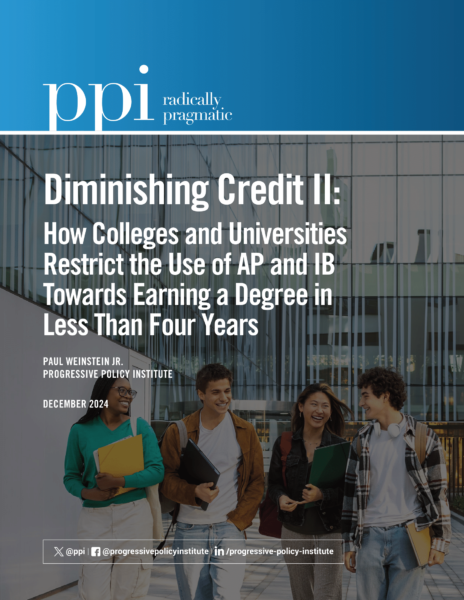Introduction
In 2016, the Progressive Policy Institute (PPI) released an analysis of school policies regarding Advanced Placement (AP) credit. Despite being one of the few ways students could seek to graduate in fewer than four years, we discovered that the vast majority of the nation’s top schools restricted students from applying AP coursework toward degree credits. Unfortunately, despite strong evidence that successfully completed AP courses meet the standards of achievement expected by colleges and universities, the situation has deteriorated significantly as more schools seek to protect their revenue streams.
Furthermore, schools have significantly diminished the value of other college-level coursework completed before matriculation. For example, U.S. universities and colleges limit the amount of course credit awarded to students who have completed coursework through the International Baccalaureate (IB) curriculum, which is increasingly offered throughout the country. PPI’s study shows that IB credit was typically denied at the same rate as credit as AP.
Today, more students than ever enroll in AP courses and exams. In 2023, 5.2 million AP exams were taken by high school students, up from 1.6 million in 2002. A study from the College Board, which owns AP, shows that 738,698 students, or 21.7% of students in the class of 2023, scored at least a 3, more than 2 points higher than the class of 2013.
Although still small by comparison to the reach of AP (almost 23,000 high schools offer AP courses), 900 high schools in America now offer the IB diploma. This number has risen considerably since 1971, when the first IB program was taught in a U.S. school. The granting of credit for AP and IB is one of the few ways students can reduce the cost of attending college. Presently, the average cost of attending a private, nonprofit college or university is $38,421, and $15,868 for a public university.
Students who successfully complete AP or IB courses in high school could graduate in some cases either one year or one semester early, saving them anywhere between 12.5% to 25% of the total cost of the degree.
Students have other tools that help them graduate college at a lower cost. According to the National Center for Education Statistics, between 20% to 50% of new university students have transferred from community college. But as students move between community college and four-year programs, many find it very difficult to navigate the system of credit transfers and agreements.
Furthermore, students looking for information on credits for AP or IB work (and courses completed at community colleges as well), often have to wait until they arrive on campus and have paid their first tuition installment. Many schools have made it increasingly difficult to figure out how much AP or IB credit will be awarded before stepping on campus. Many institutions are leaving that decision to academic departments. And more and more schools are offering only waivers on introductory courses in lieu of course credit.
For too long students have been at the mercy of college administrators — forced to pay higher tuition bills and fees for things that should be free — transcripts, tickets for graduation, etc. Policymakers need to help level the playing field by using the government’s bargaining power (the federal government is the largest source of financial aid and provides billions in research grants to colleges and universities) to negotiate lower prices and force schools to accept coursework completed elsewhere. An important step to help students get through college faster and, therefore, at a lower cost is to ensure they get credit for successfully completing college-level work before matriculating.





